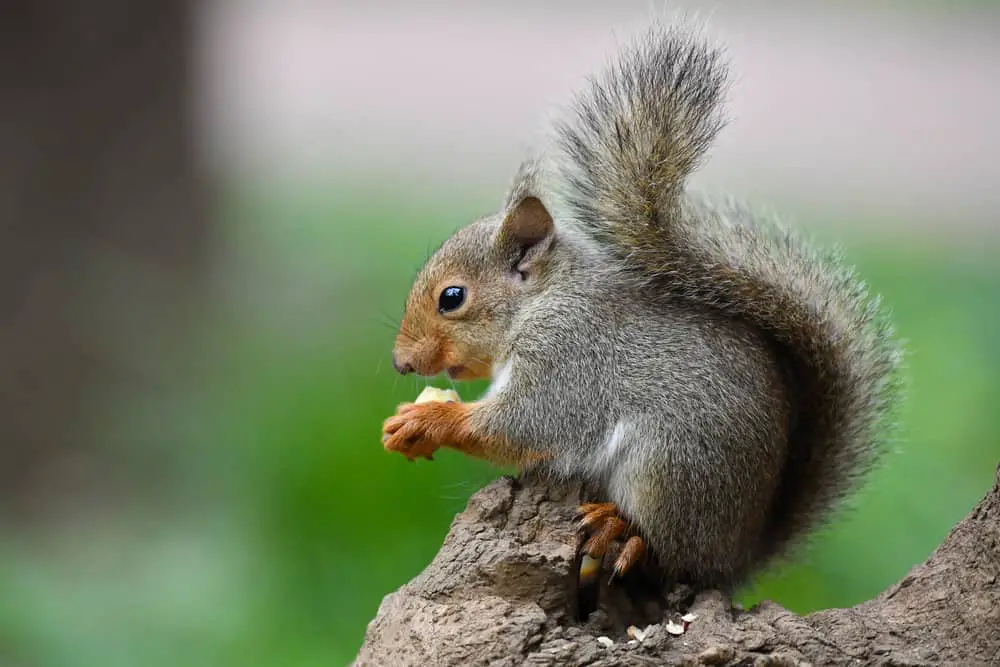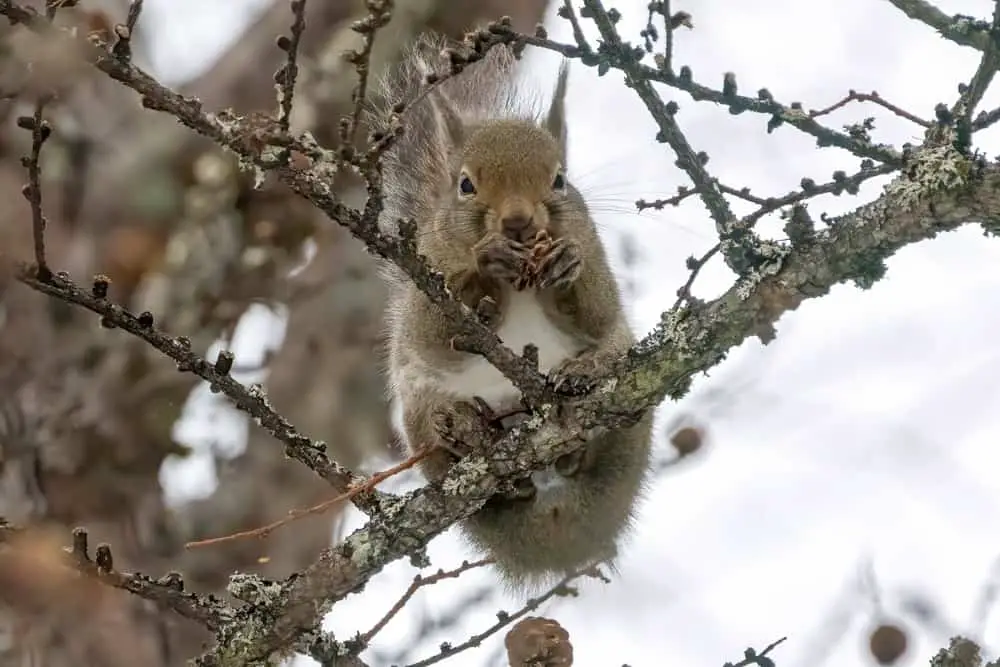Sciuridae, commonly referred to as the squirrel family, is a diverse group of rodents found across the globe. With over 280 species identified in this family, they inhabit various habitats ranging from forests to deserts and can be classified into three subfamilies: Sciurinae, Callosciurinae, and Xerinae.
The unique morphological features of Sciuridae members have made them an important subject of study for researchers who seek to understand their evolutionary history and ecological significance. One of the most distinctive characteristics of this family is their large bushy tails which serve multiple purposes such as balancing during arboreal movements or providing insulation against harsh climatic conditions.
Additionally, their complex social behaviors and dietary preferences make them fascinating research subjects that provide valuable insights into animal behavior and ecology. In this article, we will delve deeper into the world of Sciuridae exploring their distribution patterns, taxonomic classification, behavior, habitat requirements among other exciting facts about these intriguing animals.

Genera
- Genus Aeretes – groove-toothed flying squirrel
- Genus Aeromys – large black flying squirrel
- Genus Ammospermophilus – antelope squirrel
- Genus Atlantoxerus – Barbary ground squirrel
- Genus Belomys – hairy-footed flying squirrel
- Genus Biswamoyopterus – Namdapha flying squirrel
- Genus Callosciurus
- Genus Cynomys – prairie dog
- Genus Dremomys – red-cheeked squirrel
- Genus Eoglaucomys – Kashmir flying squirrel
- Genus Epixerus
- Genus Eupetaurus – woolly flying squirrel
- Genus Eutamias
- Genus Exilisciurus – pygmy squirrel
- Genus Funambulus – palm squirrel
- Genus Funisciurus – African striped squirrels
- Genus Glaucomys – New World flying squirrel
- Genus Glyphotes – sculptor squirrel
- Genus Heliosciurus – sun squirrel
- Genus Hylopetes
- Genus Hyosciurus – long-nosed squirrel
- Genus Iomys
- Genus Lariscus
- Genus Marmota – marmot
- Genus Menetes – Berdmore’s ground squirrel
- Genus Microsciurus – dwarf squirrel
- Genus Myosciurus – African pygmy squirrel
- Genus Nannosciurus – black-eared squirrel
- Genus Neotamias
- Genus Notocitellus
- Genus Otospermophilus
- Genus Paraxerus – African bush squirrel
- Genus Petaurillus – pygmy flying squirrel
- Genus Petaurista – giant flying squirrel
- Genus Petinomys
- Genus Poliocitellus – Franklin’s ground squirrel
- Genus Priapomys – Himalayan large-eared flying squirrel
- Genus Prosciurillus
- Genus Protoxerus – African giant squirrel
- Genus Pteromys – Old World flying squirrel
- Genus Pteromyscus – smoky flying squirrel
- Genus Ratufa – oriental giant squirrel
- Genus Rheithrosciurus – tufted ground squirrel
- Genus Rhinosciurus – shrew-faced squirrel
- Genus Rubrisciurus – red-bellied squirrel
- Genus Sciurillus – Neotropical pygmy squirrel
- Genus Sciurotamias
- Genus Sciurus
- Genus Spermophilopsis – long-clawed ground squirrel
- Genus Spermophilus
- Genus Sundasciurus
- Genus Syntheosciurus – Bangs’s mountain squirrel
- Genus Tamias
- Genus Tamiasciurus – pine squirrels
- Genus Tamiops – Asiatic striped squirrel
- Genus Trogopterus – complex-toothed flying squirrel
- Genus Xerospermophilus
- Genus Xerus – African ground squirrel
Taxonomic Classification Of Sciuridae
The family Sciuridae is a diverse group of rodents commonly known as squirrels, chipmunks, and marmots. They are widely distributed throughout the world except for Australia and Antarctica.
The taxonomic classification of this family has been subject to much debate due to their morphological similarities and convergent evolution. However, with recent advances in molecular phylogeny, there have been significant changes in the classification of sciurids.
The evolutionary history of sciurids dates back to the Eocene period approximately 50 million years ago. Fossil evidence suggests that they evolved from small arboreal mammals similar to modern-day tree shrews. Over time, these early ancestors diversified into various lineages resulting in the present-day diversity we see today.
With molecular phylogenetic analysis, it has become apparent that some genera previously classified as part of Sciuridae should be separated into other families such as Aplodontiidae or Gliridae. Furthermore, several subfamilies within Sciuridae have also been reclassified based on genetic relatedness rather than physical characteristics alone.
Distribution Patterns: Where Can You Find Sciuridae?
As we have seen in the previous section, sciuridae belongs to the family of rodents that includes squirrels, chipmunks, and marmots. These creatures are found all over the world except for Australia and Antarctica. However, their distribution is not uniform across different regions because they prefer specific habitats.
Habitat preferences:
- Different species of sciuridae require different types of forests such as deciduous, coniferous or mixed.
- Ground squirrels prefer open grasslands while tree-dwelling species like flying squirrels need tall trees with dense foliage.
- Some species can survive in urban environments like parks and gardens.
- Alpine marmots live in high altitude areas above treelines.
Migratory patterns:
- Most species of sciuridae do not migrate long distances but may move from one area to another according to seasonal food availability.
- Some populations may hibernate during winter months when there is a lack of food resources.
- Certain species undertake short-distance migrations between higher altitudes during summer months and lower elevations during winters.
- The Arctic ground squirrel migrates up to 30 km each year from its winter burrow to its summer range.
Understanding these habitat preferences and migratory patterns is essential for conservation efforts aimed at protecting these animals against habitat loss due to human activities like deforestation and urbanization. By studying their behavior, researchers can develop effective strategies for preserving the biodiversity of our planet’s ecosystems where sciuridae plays an important role as seed dispersers and prey for larger predators.
The Morphology Of Sciuridae: Examining Unique Features
The morphology of sciuridae is characterized by unique features that have evolved over millions of years to help these animals survive in their environment. One such feature is their sharp and curved claws, which are used for climbing trees and digging burrows. In addition, they possess strong hind legs that enable them to jump from one tree branch to another with ease.
The evolutionary history of sciuridae dates back to the Eocene epoch, approximately 56 million years ago. Over time, various adaptations for survival have emerged, including hibernation during winter months when food sources are scarce. This adaptation allows them to conserve energy while minimizing exposure to predators. Other adaptations include their keen sense of sight and hearing, which helps them detect potential danger from afar. Altogether, these unique morphological features make the sciuridae a highly successful group of mammals that continue to thrive across different regions of the world.
| Unique Features | Emotional Response |
|---|---|
| Strong Hind Legs | Amazement at how easily they can move through trees |
| Sharp Claws | Fascination with their ability to climb and dig |
| Hibernation Adaptation | Appreciation for their ability to adapt and overcome challenges |
| Keen Senses | Respect for their evolutionarily honed survival skills |
Social Behaviors: Insights Into The Lives Of Sciuridae
The Morphology of Sciuridae has provided us with insights into the unique features that make these animals remarkable. It is however important to understand how social behaviors can impact the lives of sciuridae, as it plays a crucial role in their survival and reproduction.
One interesting statistic is that gray squirrels have been observed to communicate using vocalizations, facial expressions, and tail movements. This highlights the importance of communication methods among members of this family, which are used for various purposes such as warning others about predators or locating food sources.
In addition to communication, social hierarchies also exist within groups of sciuridae. Understanding these interactions can provide valuable information on factors such as mating behavior and resource allocation. Importance in mating behavior and resource allocation are two key aspects of social hierarchies.
Overall, gaining insight into the social behaviors of sciuridae is essential in understanding their complex dynamics. By examining communication methods and social hierarchies we can begin to unravel some mysteries surrounding their survival strategies and reproductive success.
Habits And Habitat Requirements Of Sciuridae
Feeding habits of sciuridae vary depending on the species and their geographical location. Some species are herbivores, feeding mainly on fruits, nuts, seeds, and leaves while others have a more omnivorous diet including insects, small mammals, and bird eggs.
For example, squirrels in temperate regions tend to rely heavily on acorns during fall and winter months when other food sources become scarce. Ground-dwelling species like prairie dogs feed primarily on grasses but will also consume insects as part of their diet.
Nesting behaviors among sciuridae also differ between species. Tree-dwelling squirrels build nests known as dreys from twigs and leaves suspended high up in trees for safety reasons. Underground dwelling ground squirrels dig burrows with multiple chambers where they store food and raise young ones.
Prairie dogs construct extensive underground tunnel systems that include sleeping quarters, nurseries, latrines, and even listening posts to detect predators approaching above ground level. The nesting behavior of each species is adapted to its specific environment to ensure survival in the wild without compromising individual or communal safety.
Ecological Significance Of Sciuridae: Understanding Their Role In Ecosystems
The Habits and Habitat Requirements of Sciuridae were extensively discussed in the previous section. Now, we will delve deeper into understanding their ecological significance by examining their role in ecosystems.
A metaphor that can be used to describe this is a puzzle piece – each species plays a crucial part in completing the whole picture of an ecosystem.
Sciuridae have significant impacts on maintaining various ecosystem services such as pollination, seed dispersal, nutrient cycling, and pest control.
For instance, tree squirrels help disperse seeds by burying nuts which then grow into trees, contributing to forest regeneration. Ground squirrels are known to improve soil quality through burrowing activities which increase water infiltration and soil nutrient availability for plants.
Additionally, ground squirrels also serve as prey for predators like eagles and foxes thereby playing a key role in regulating predator-prey dynamics within food webs.
Understanding population dynamics is critical for identifying changes or declines in sciurid populations which may indicate negative environmental trends or threats to biodiversity.
Therefore, conservation efforts should focus on monitoring sciurid populations and addressing any factors that affect them negatively including habitat loss due to deforestation or urbanization, climate change, hunting pressure from humans or predation from invasive species.
In summary, sciurids play essential roles within ecosystems both directly (as agents of ecosystem services) and indirectly (through regulation of trophic cascades).
As research continues to reveal their importance in maintaining healthy ecosystems and mitigating anthropogenic disturbances such as habitat fragmentation or degradation, it becomes increasingly important to conserve these animals’ habitats while also ensuring their protection against human interference.

Conclusion
Sciuridae, commonly known as squirrels, are a diverse family of rodents that inhabit various ecosystems across the globe. With over 280 species identified to date, Sciuridae has a widespread distribution and plays an essential role in several ecological processes.
The morphology of sciurids is unique and varies among different species; they have specialized teeth used for gnawing on nuts and seeds, long bushy tails used for balance during climbing, and sharp claws adapted for gripping tree trunks. Additionally, their social behaviors vary from solitary to group living depending on the species. Their habitat requirements range from forests to urban environments where they can find shelter and food.
Despite being considered pests by some humans due to their habit of raiding gardens or chewing on wires, Sciurids play a crucial role in maintaining forest health by dispersing seeds through caching behavior. They also serve as prey for numerous predators such as hawks, owls, foxes, snakes amongst others.
Therefore conservation efforts should be made towards preserving these animals’ natural habitats amid increasing anthropogenic pressures. In conclusion, studying Sciuridae provides valuable insights into understanding animal adaptation mechanisms, resource utilization patterns within ecosystems and ultimately contributes to biodiversity conservation strategies globally. It is important that we continue researching this fascinating family of rodents while ensuring their survival alongside other organisms in their respective ecosystems.

